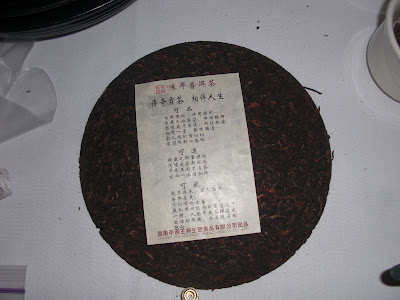
A dry tea blossom and our "special" tea blossom in bloom
We started our session learning about White Teas, (uncured and unfermented buds or young leaves and buds) and the three grades: Silver Needle (Bai Hoa Yinzhen), White Peony (Bai Mu Dan), and finally Shou Mei (which apparently means "Noble, Long Life Eyebrow"). Silver Needle is the highest grade of white tea, usually coming from the Chonging and Fujian Provinces of China. Silver Needle usually contains only the tea buds and is harvested only once per year in the spring. I didn't get a strong aroma from the dry tea leaves but the aroma was a bit stronger with the wet leaf, smelling sweet and fresh. The flavor and liquor were very light and delicate, slightly sweet and some slight floral notes.

Silver Needle in the cup
The second grade, White Peony, is considered a grade down from Silver Needle using both the bud and the top two leaves of the tea plant. It may have more than one "flush" or plucking each year and has a fine white "down" covering the leaves. The aroma of this tea, at least the wet leaves, was a bit stronger and I picked up some very light lemony or citrus notes in the flavor.

White Peony Leaves and Buds

After our foray into White Tea, we went back to the green teas from China that we didn't finish tasting from the last class: starting with the Bi Luo Chun, a hand-processed, artisan tea from the Jiangsu Province. It is usually wound tightly into "spirals" and has a variegated sliver color. This tea is known for picking up the fragrances of the plants that surround it, like citrus, trees, so I was looking forward to tasting it but unfortunately the flavor turned out to be pretty bitter. I am not sure if we ended up brewing it too long, but it was definitely bitter and not just the astringent edge you get from some green teas. It had a vegetable like smell and taste--a bit like (bitter) asparagus.

Bi Luo Chun leaves in small spirals


Huang Shan Mao Feng--longer straight leaves

Huang Shan Mao Feng after brewing
For the Chinese Green teas we ended with Mao Jian from the He Nan Province. This tea had a smaller leaf than the second tea and the leaf was not as curled as the leaf of the first tea we tried. The wet leaf had a slight vegetable smell and the flavor reminded me of cooked green beans. (I have to relate everything to the taste of food!). This tea was more astringent than the second tea, but not in a bad way and it was not bitter.

Mao Jian Leaves


5 year old Pu'erh Cake--the paper is its information and certification
The first Pu'erh we tried was an "Aged Cake" Pu'erh from 2002 and from the Yunnan Province. We wore gloves and passed the large cake around and broke off pieces to brew. I had a hard time breaking off a really small piece and was a bit worried mine would be way too strong when I compared it with my neighbors' pieces! The dry cake smelled (and looked) like a clod of soil from the yard, very earthy).
My piece of the cake
To brew it, we first covered the piece of cake with hot water for about 15 seconds in order to soften it.
Pu'erh softening
We then poured off the water and put in more water (about 200 degrees F.) and then brewed it about 1.5 minutes. The result was a dark, strong cup that tasted very smooth, earthy and robust. Very drinkable and very nice, reminding me of the way the ground of a forest smells.

My Pu'erh brewed--nice and dark
Our second Pu'erh was a loose leaf one, also from the Yunnan province. The smell of the leaves was not as strong as the smell of the brick and the flavor was not as strong either (but that might have been partly due to the size of the piece of brick I took). The taste was still still very earthy and smooth, reminding me of the way a mushroom tastes. Again very drinkable with little astringency.
The loose leaf Pu'erh

The loose leaf Pu'erh brewed
A great class and a good chance to try and learn about some less common teas. We were also given a couple of things to take home and try--some Jasmine Dragon Phoenix Pearls and a small, individually wrapped, Pu'erh cake. (Like the small, unwrapped one in the lower right corner of the bird's nest Pu'erh picture) I will be trying them and posting about them soon.


when we went to Shanghai, a couple of years ago, we bought pu-erh tea. love it :) what a great class! oh and I agree that those flowering bloom teas don't taste like much, but they do look nice.
ReplyDeleteWow-that is an amazing array of interesting teas!
ReplyDeleteI had no idea about the existence of a Prudence Penny! Let alone a cookbook! I'd love to get my hands on it and would be more than happy to pay you for it. How interesting! You really do have an immense collection of cookbooks, don't you? Thanks so much for thinking of me! Prudence Penny with a wise at the end:)
Hi Deb. I just wanted to say a huge thank you for sending me a Blogging by Mail package. I feel so bad that you went through all that trouble just so i wouldn't go without a package. It really is so sweet and kind of you. Thank you so much once again- i'm currently overseas at the moment and will only be back in Singapore end of the moment but i'm looking forward so much to seeing what's in that box.
ReplyDelete